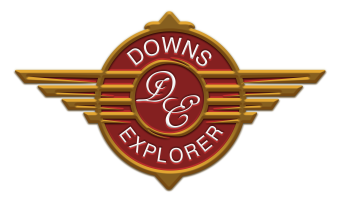The C17 Steam Locomotive
Type: C17
Built: Betwwen 1920 – 1953
Builders: Ipswich Railway Workshops – (16 units)
Walkers Ltd – (138 units)
Evans Andersons and Phelan – (28 units)
Armstrong, Whtworth & Co. – (25 units)
Clyde Engineering – (20 units)
Weight: 56.8t (engine + tender when empty) 82.9t (engine + ender when full)
Length: 16.3m
Width: 2.620m
Height: 3.8m
Boiler pressure: 7,206 kPa
Tractive effort: 93.4kN
Coal: 8.13t
Water: 13,865l
Driving wheels: 1.14m in diameter
Grate area: 1.719 sqm
Valve gear: Walschaerts
Gauge: 1,065mm gauge (3ft 6in)
Queensland Steam Locomotive codes are derived from the number of drive wheels and the size of the cylinders.
- “A” denotes that the engine has 4 driving wheels, (2 on each side),
- “B” that the engine has 6 driving wheels (3 on each side), and
- “C” has eight driving wheels (4 on each side).
The number after the letter is the cylinder size in inches. Thus C17, is a steam locomotive with 8 driving wheels and a 17″ cylinder. (Aren’t we glad that QR didn’t recode their locomotives when decimalization was introduced, other wise it would now be called a C432.)
No.971 is the nine hundred and seventy first steam locomotive built for Queensland Railways!
A total of 227 C17’s were built for use on Queensland Railways. These locomotives were built by various makers both in Australia and overseas. The design was also used by the Commonwealth Railways which operated on the Central Australian narrow gauge railway, (“The Old Ghan”) to Alice Springs. The first C17s entered service in the 1920s. In 1938 an updated version was introduced, which had a bigger sedan type cab and other changes.
The main reason so many of this class were constructed was that it was the most powerful form of conventional locomotive that could run on Queensland tracks, regardless of the limitations of axle loading.
In June and November 1947 contracts were let to Walkers Ltd, Maryborough Queensland, for a total of 40 more C17 locomotives, with Timken Roller Bearings fitted to all axles. These locomotives began entering service in 1950.
The Walkers Ltd engines were all painted in a medium brown colour scheme with willow green lining on the footboards, and tender edges, a black smokebox and red buffer beams. They had polished brass bands around the boiler. The engines were nicknamed ‘Brown Bombers’ after the world heavyweight boxing champions of the time, Joe Louis.
The C17 class of locomotive was an improved superheated version of the C16 class goods locomotive, which appeared in 1903.
The C17 locomotive being overall the most numerous class of Queensland engine and was also possibly its most versatile. It worked almost any train in Queensland, be it suburban passenger, goods train, shunter or even hauling air-conditioned trains in western Queensland.
